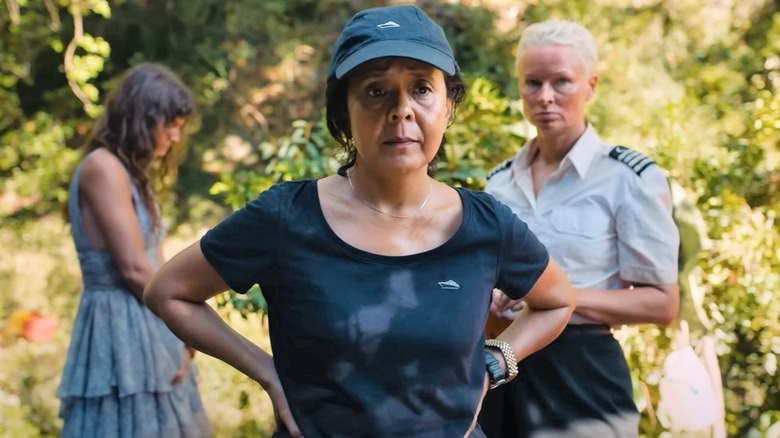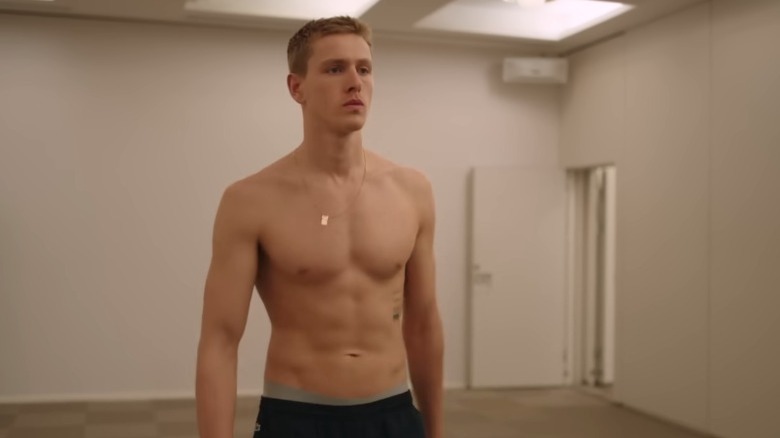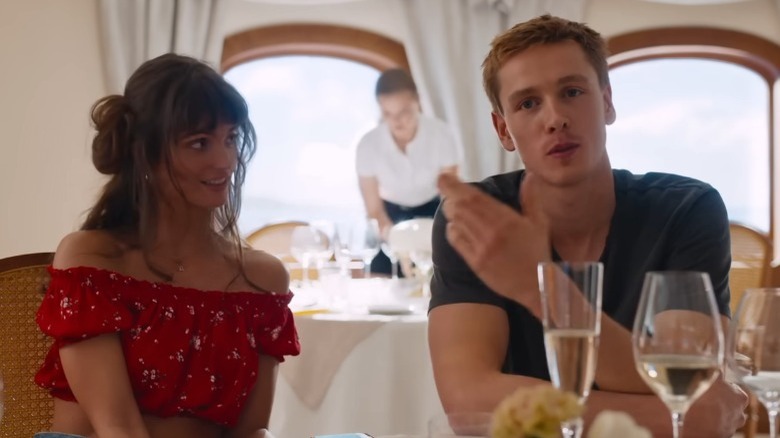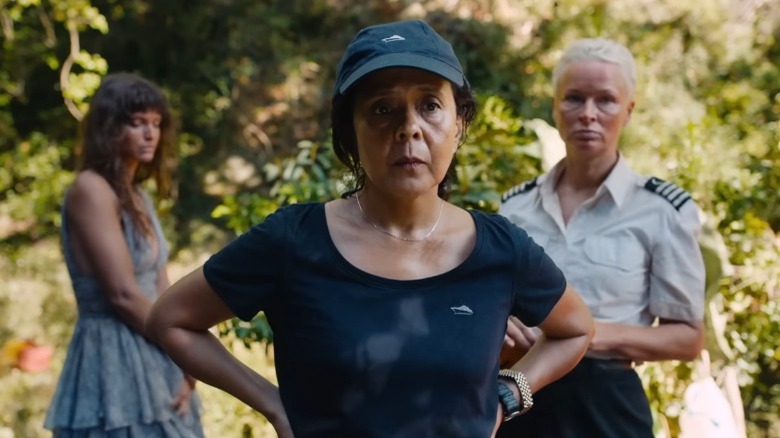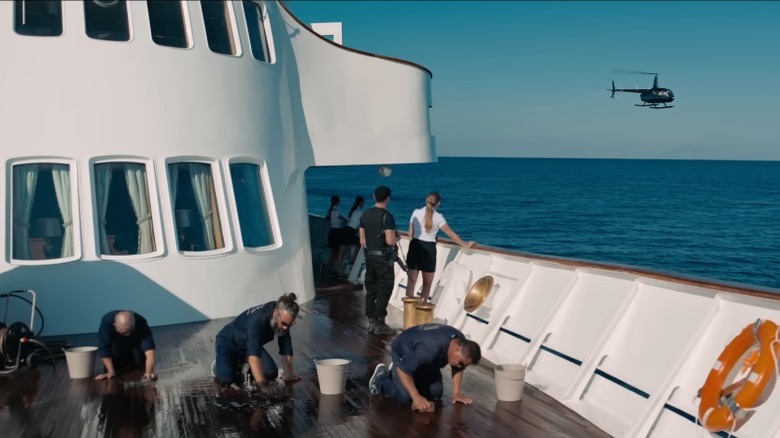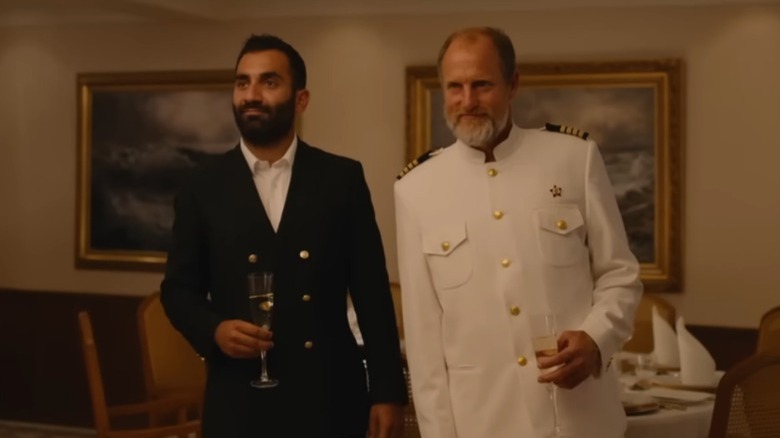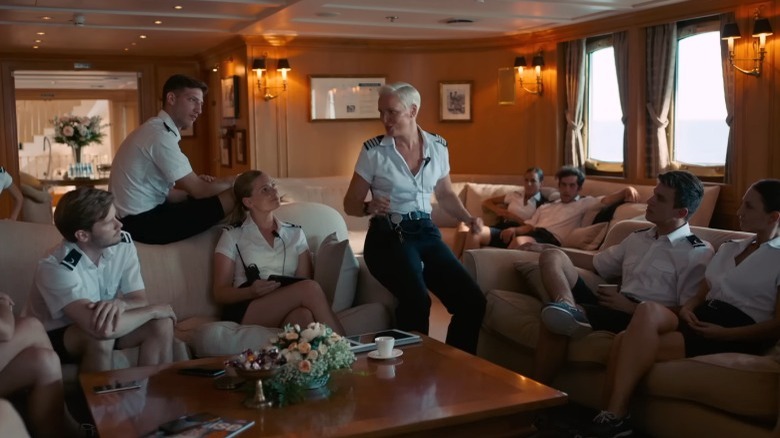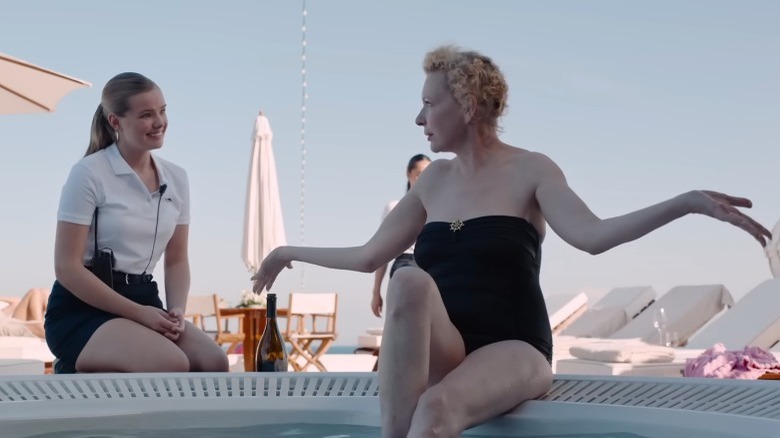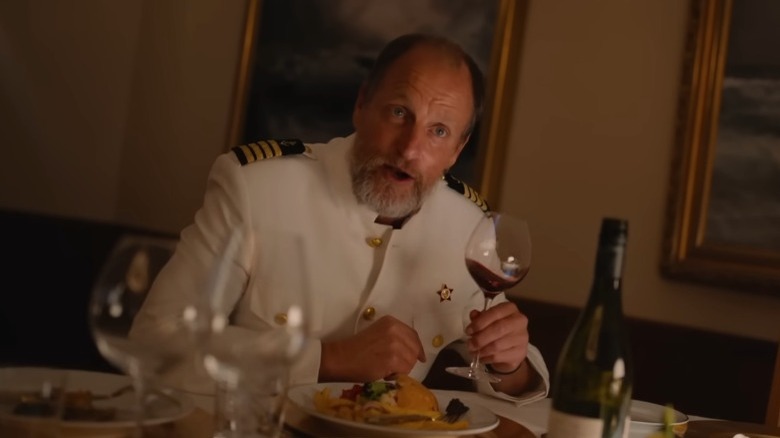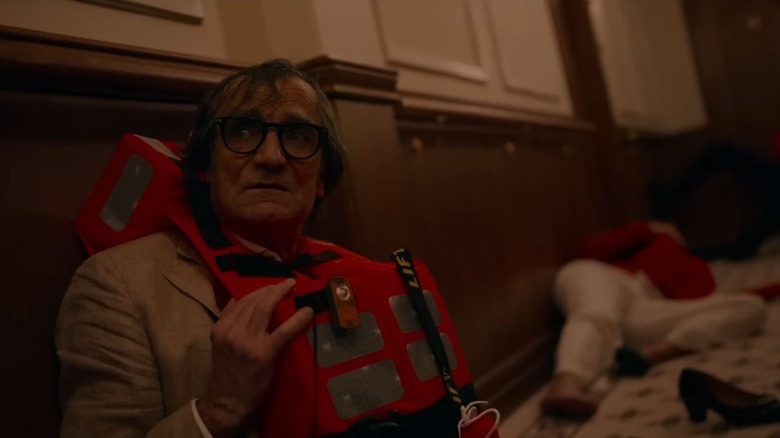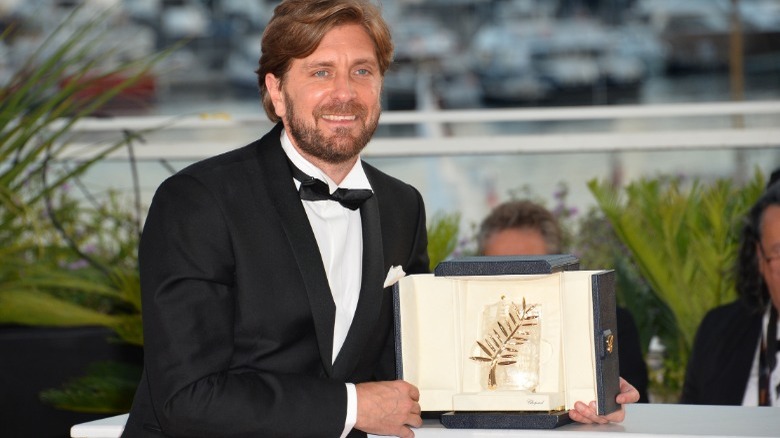Triangle Of Sadness: Set Sail With These 11 Facts About The Oscar-Nominated Film
Ruben Östlund's "Triangle of Sadness" really has it all. From fashion models to a vomit-soaked yacht to a worst case scenario survival situation, every turn the movie takes will leave you shocked — and more than a few will have you laughing out loud.
The story begins with the relationship struggles of Yaya (Charlbi Dean) and Carl (Harris Dickinson), a couple who each work as professional models. Before too long, however, their trip on a luxury yacht turns into something that might feel more like "Lord of the Flies" if it weren't so funny. It all builds to a stunning ending sure to linger in the viewer's mind for weeks.
"Triangle of Sadness" won the Palme d'Or at the 2022 Cannes Film Festival, but even after that impressive achievement, the film still turned out to be one of the biggest surprises among the 2023 Oscar nominations. Östlund's movie earned him a nomination for Best Director and landed amongst the Best Picture nominees.
For every brilliant moment that happens on screen, there are a hundred details and thousands of hours of work of which most audiences will never even be aware. Below, a breakdown of what's under the surface in the Oscar-nominated "Triangle of Sadness."
Ruben Östlund got the movie idea from his girlfriend
"Write what you know" is common advice, but Ruben Östlund's career proves that it shouldn't be taken too seriously. Östlund's 2014 breakout hit, "Force Majeure," followed a family running into a massive avalanche while on vacation in the French Alps. He followed that movie up with 2017's "The Square," a biting satire about an art museum curator; it received an Oscar nomination for Best Foreign Language Film of the Year.
Now Östlund isn't an expert skier or professional curator, but part of his talent as a filmmaker is an ability to soak up information and convey it onscreen in a way that feels remarkably authentic. 2022's "Triangle of Love" takes another deep dive into a very specific slice of life: The professional modeling industry. Östlund has virtually no experience with modeling himself, but he told Variety that the idea for the film came from his girlfriend. She works as a modeling photographer, and her stories about various jobs and clients caught Östlund's interest. His girlfriend's stories became the foundation for two of the film's protagonists, Carl and Yaya. From there, Östlund took the story in a slightly different direction, eventually landing on a luxury cruise and a devastating shipwreck.
The production was hit by pandemic delays
Like so many films in recent years, "Sadness" had a stop-and-go production that constantly teetered on the brink of disaster thanks to the pandemic. By the time COVID-19 hit, the movie had already been in the works for years. Ruben Östlund began putting the cast together as far back as 2018 (via Variety). By the time 2020 rolled around, everyone was itching to get started, but getting the filming done wasn't smooth sailing.
According to Deadline, disaster struck almost as soon as the production got started. Östlund and the crew were able to work for 25 days before the pandemic sent everything into shutdown. As weeks removed from work stretched into months, Östlund said, "I started to feel like maybe the film wouldn't happen." Filming went on to have a 3 month delay, and getting everyone back on set involved coordinating pandemic policies across multiple countries. Eventually everything worked out, but the process of taking "Triangle of Sadness" from the page to the big screen took roughly four years.
Dolly de Leon took Abigail very seriously
Östlund wrote "Triangle of Sadness" knowing what he wanted the final product to be, but without a supremely talented cast he wasn't going to get very far. The filmmaker cast a wide net to find the perfect actors to bring his characters to life. To general audiences, Woody Harrelson might be the most recognizable face among the cast, but anyone who's seen the movie knows that Dolly de Leon (as Abigail) is really the star of the show.
De Leon was born in the Philippines, spending more than 30 years building an acting career there. She best known for her work in dramatic films like 2019's "Verdict" and 2021's "Historya ni Ha," but de Leon is also no stranger to television, like her 55 episodes stint on "Pintada."
When it came to join the cast of "Sadness," de Leon actually didn't like her chances, but she went to the audition anyway. "I just thought, 'No one ever chooses me, so I'll just go and have fun with it,'" she told The Hollywood Reporter. She landed the role in 2018, but had to wait two years before she could actually walk on set. In the meantime, de Leon dissected the psychology of her character Abigail. She kept journals to flesh out Abigail's backstory and even started working to prepare for life on the island. By the time production got underway, de Leon knew Abigail like the character was her own sister.
It was Charlbi Dean's last movie
Charlbi Dean was a South African actress who made her acting debut in the 2010 film "Spud," written and directed by Donovan Marsh. She went on to have roles in movies like "Don't Sleep" and "Porthole," and in 2018 she had a brief recurring role on the CW show "Black Lightning."
In "Triangle of Sadness," Dean portrays Yaya, a female supermodel who, along with her boyfriend Carl, gets invited on a yacht trip for billionaires, celebrities, and influencers. Yaya's relationship is strained because she's significantly more successful than Carl, and their discussions about differing roles in the fashion industry take center stage at the beginning of the film.
Tragically, Dean died in August of 2022, shortly after finishing work on "Triangle of Sadness." Dean's death was caused by sepsis, which developed from a rare bacterial infection called Capnocytophaga. The same day that she began showing symptoms, Dean asked her fiancé to take her to the hospital, and hours later she died. She was 32 years old.
Dean's performance in the movie has been highly praised as one of the best parts of the film. Discussing how her loss impacted the rest of the cast and crew while finishing production and beginning promotion for the movie, director Östlund told the Independent, "Someone is not there that should be next to us. That makes it very, very sad."
The movie upset some viewers
Since debuting, "Triangle of Sadness" has received generally positive reviews, but not everyone in the audience will walk away satisfied. One vomit-centric scene in particular has left some viewers with a bad taste in their mouths.
A writer for BBC Culture said that the movie, "belongs to that much-maligned group of films that dwell on the icky bodily functions which we prefer to keep behind closed doors." That might be overstating things, but thanks to that lengthy scene, "Triangle of Sadness" certainly isn't the movie for those with a weak stomach.
It's not only the puke-averse who were most bothered by what Östlund presented in his film, however. According to the Independent, after a screening of the film in Paris, one audience member was so upset that he stood up and shouted about it. The man, described only as "one of the richest persons in France," thought that the movie was unfairly critical of the wealthy. Considering how explicit the satire of the movie is, it's hard to see getting under the skin of the upper class as anything but a victory for the film as a whole.
Östlund wanted to make people ask questions
It's hard not to view "Triangle of Sadness" from a political lens. From its various settings to its characters (particularly Harrelson's Marxist yacht captain), the film seems to be begging audiences to consider how politics, economics, and social class affect people's behavior.
Much of the movie's focus comes out of Östlund's own upbringing. He told Vox that when he was growing up, his mother was a '60s leftist while his brother grew up to be a conservative. What they had in common was a love for debating and discussing ideas. "Every Sunday dinner we had, it was always these two ideological bashes," Östlund said. Those debates stoked his own curiosity, and now he uses his films to create questions for his viewers.
The questions are more important than any potential answers in "Triangle of Sadness," and Östlund told the Independent that he was more interested in getting an audience to examine ideas for themselves than in spreading a message. Instead of viewing some of his characters as villains and others as heroes, he says, "No, they are human beings." Everyone in the film has the potential to do good and bad things, even if some characters have a habit of choosing one over the other more often than not.
Östlund did some serious research for the film
Every good writer does at least some research before committing to a new project. Östlund got his interest in the fashion world by hearing his girlfriend's stories about being a photographer in the industry (via Variety). She told him about the job's unique gender dynamics, and that set up his movie's first two characters, Carl and Yaya.
For some, that would have been more than enough. The movie already had characters and a bit of conflict that were somewhat based on reality, or at least based on one person's real-life experience of a particular industry. Östlund wasn't satisfied with that, however, so he decided to take things a step further.
Östlund told Vox that because he already had a sense of the larger, class-based conflicts he wanted to present in the film, "I also [tried] to find sociological studies because they're good to use as an example of what I'm aiming for." One of the studies he read that most impacted the film was a deep dive on how zebras use their stripes as camouflage within the herd, rather than within their surrounding environment. He related that to how Carl and Yaya have to change themselves to conform to the expectations of those around them. While the 15 minute vomit scene might be what sticks out in the audience's memories, but there's a lot more under the surface of "Triangle of Sadness."
The actors shot 20 takes at a time
Östlund's films have been successful, in part, because of an extreme level of commitment to making them perfect. Östlund spent nearly half a decade researching, writing, casting, shooting, and editing "Triangle of Sadness," and it's hard to say whether or not the movie would have received the same response if at any point Östlund had decided to take things easy. He's willing to sink an incredible amount of time into his films, but he also asks more of his cast than many other directors.
Shortly after the release of his 2014 film "Force Majeure," Östlund revealed that his process on set is both intense and methodical. He told Filmmaker Magazine that he tried to focus on a single camera position every day of the shoot and that he would film an average of 40 takes back-to-back. The process could be exhausting, and it stretched out the length of the entire production, but it gave him the results he wanted.
With "Triangle of Sadness," Östlund fundamentally kept the same approach. Dolly de Leon told an interviewer that Östlund "works actors really hard." She said that her shortest scene in the film was shot in eight takes, but that once Östlund had her perform nearly 60 takes to get a scene just right.
One scene sold Woody Harrelson on the film
The cast of "Sadness" really shines. They bring an already strong script to an entirely different level with their performances. Ruben Östlund knew just how important getting the right cast would be, so he was as methodical with finding them as he was with shooting them on set. According to Dolly de Leon, Östlund's casting director spent four days in the Philippines, meeting with actresses who could potentially play Abigail in the movie.
Of course, casting isn't just about finding the perfect person for a role. Sometimes it also involves talking them into playing the part. Östlund decided that Woody Harrelson was exactly who he wanted for the yacht captain in the film, but he wasn't sure if Harrelson would take the part.
It turns out, Östlund never needed to have doubts. He told A.frame that he pitched the film to Harrelson by describing its most over-the-top scene. "I said, 'Okay, you are going to a Marxist captain and you are going to read from The Communist Manifesto to s****** and throwing up guests on a luxury yacht." Some actors might have been horrified by Östlund's description and his ideas, but not Harrelson. His response? "Wow. I'm in. This is great."
The grossest scene took the most effort
There are so many scenes in "Triangle of Sadness" that are worth remembering, but the most shocking of them has to be the vomit scene. It's the scene that sold Harrelson on the film, and it's the scene that caused the BBC to conclude that "Triangle of Sadness is a gross-out movie." For some, the vomiting was the end of the movie for them; for others it was a high point. Either way, it certainly has stuck in the imaginations of everyone who's seen it.
That is precisely the impact Östlund hoped the scene would have. He told A.frame that he planned to push the scene further than any audience would expect, both in terms of graphic content and in length, but it wasn't easy. The set was built on a gimbal, and after hours of filming while spinning, some crew members needed to take seasickness pills to keep it together.
Östlund had a secret weapon in the scene that even he hadn't anticipated. "[Sunnyi Melles] is a very special actor," he said, adding, "I have never worked with someone that is so physical, and actually, she could provoke vomiting by herself." Even with a top-notch set, a dedicated crew, and superhuman actress, the scene still wasn't finished. Östlund spent six months editing it to perfection after the shoot, and he ended up creating one of the grossest, most hilarious scenes in recent cinematic history.
The film started a streak for its director
After sitting down to watch "Triangle of Sadness," audiences across the world are finding themselves either disgusted with or fascinated by the imagination of Ruben Östlund. Either way, some serious recognition of the work that went into the film has rolled in. At the Academy Awards alone, "Sadness" picked up three nominations, including a best picture nod, but those awards probably aren't even the peak of Östlund's excitement about the film's reception.
Back in 2017, Östlund's film "The Square" swept the Cannes Film Festival while walking away with the festival's highest honor, the Palme d'Or. Few directors ever win the award; now, with "Triangle of Sadness," Östlund has done it twice.
Östlund is only the 10th director to ever win the award for a second time, which means he now gets to see his name next to acclaimed filmmakers like Francis Ford Coppola, Ken Loach, and Michael Haneke. His acceptance speech at Cannes began breathlessly and ended with massive cheers from his fellow filmmakers in the audience.
